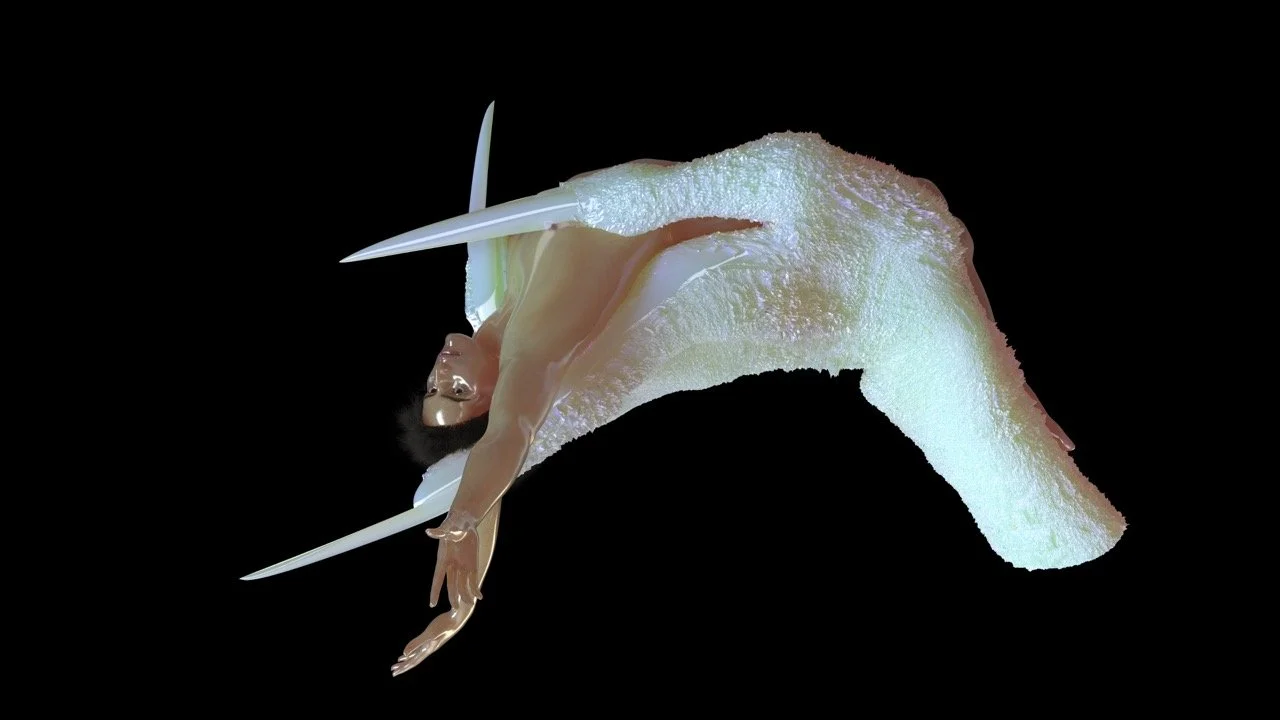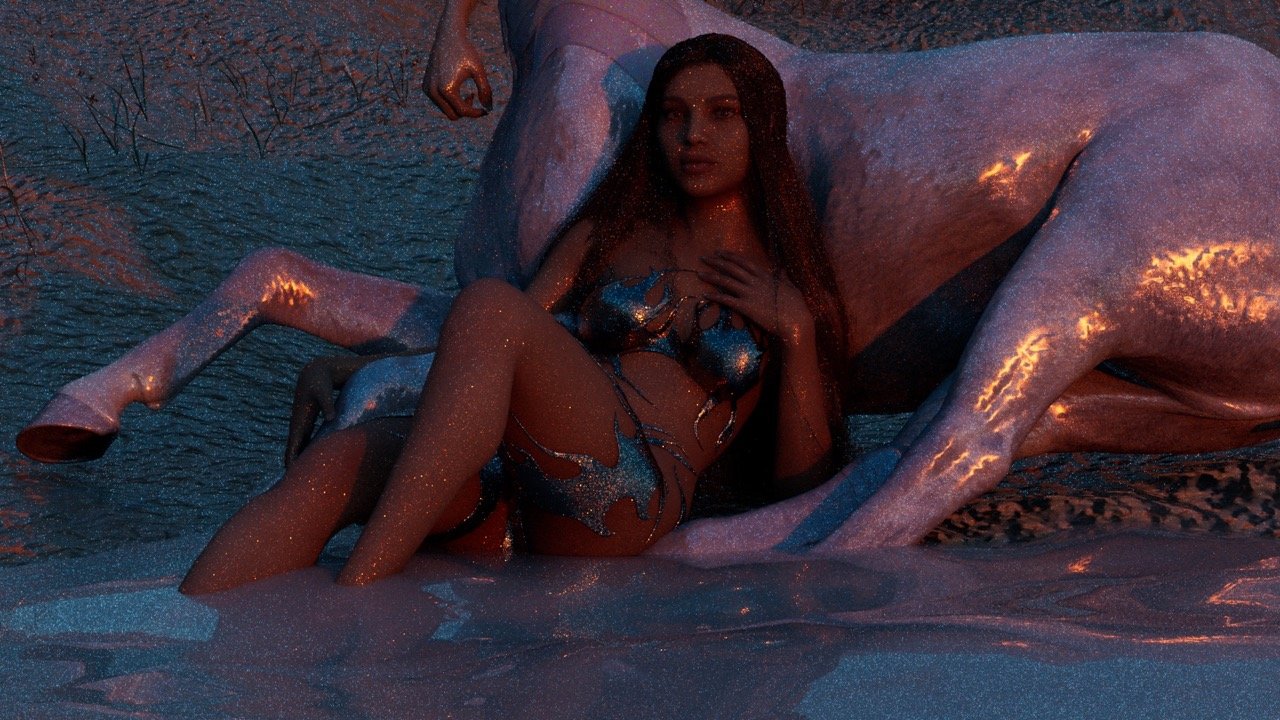Bassam Issa Al-Sabah
Bassam Issa Al-Sabah I AM ERROR, 2021 Video HD, 30 min Film still Commissioned by Gasworks, in partnership with De La Warr Pavilion.
Oscillating from online universes, post-apocalyptic and fleshy realities, Bassam Issa Al-Sabah is a multidisciplinary artist that lives between Dublin and Glasgow. Spanning different media from video, installations and textile, their practice explores questions of resistance, world-making and post-capitalist desire.
Inhabiting a place of contradictions and possibilities, at the threshold between immemorial mythologies and queer futures, their CGI film fluctuates in mesmerising digital landscapes and sculptural installation at the edge of catastrophe.
Taking inspiration from Arabic-dubbed anime memories, fan cultures and autobiographical anecdotes, their movies are an attempt to deconstruct colonial legacies while fostering new conceptualisation of selfhood and togetherness in constant becoming.
Their last movie ‘Uncensored Lilac’ in collaboration with Jennifer Mehigan for transmediale festival ‘you’re doing amazing sweetie’ is a feminist fabulation about a group of cynical goddesses navigating climate collapse, a glitch of intimacy where unprecedented visions of the world can emerge.
Alice Minervini aka pakkiana is an artist and curator exploring intersections between fiction, new technologies and erotism as ways to envision alternative futures.
Bassam Issa Al-Sabah I AM ERROR, 2021 Video HD, 30 min Film still Commissioned by Gasworks, in partnership with De La Warr Pavilion.
I personally obsessed over your immersive installation for I AM ERROR in 2021 in London. I was writing my Master's research on Dancing with Glitch, exploring how glitching ruptures and movement re-activates phantasmagorical conceptions of the body, simultaneously making and unmaking of identity, provoking further self-discovery and liberation… I really loved how the body fluctuates in your videos at the threshold between gaming and idyllic, crystallising the bubbling euphoria of online experimentation, and how the avatars are shaped by affective encounters whether human or non-human. How does the ambivalence of digital bodies challenge conventional notions of selfhood, kinship and sexuality in your work?
I think CGI is an interesting space to discuss these ideas because it is very seductive, but when that seduction is broken the illusion shatters and you realise it is a hollowness. I like the characters to exist in this hollowness, so the boundary between their bodies and the landscapes they inhabit start to break down — they are always falling in and out of nothingness. Sometimes I like to embrace the technical failures in CGI, where various elements fail to commit to each other and objects intrude and protrude where they shouldn’t.
Bassam Issa, IT’S DANGEROUS TO GO ALONE! TAKE THIS, 2022, Installation view, The Douglas Hyde Gallery of Contemporary Art, Dublin. Image courtesy The Douglas Hyde and the artist. Photography Louis Haugh.
In your installations, digitally sculpted objects constellate the immersive atmosphere of your animations. How do these tangible elements contribute to the viewers’ synesthetic experience and what role does the audio play in transporting the audience through alternative interpretations of history?
The idea behind the sculptures is that the world of the film interrupts the physical space through the sculptures. Usually they are at a scale that is larger than life, with huge body parts coming out of the ground, or fragments of a torso suspended on steel bars. The sculptures themselves are sometimes glitched or unreal, tying them to the dream-like space of the film... but I also like to place the plastic nature of digitally printed and sculpted works in conversation with other pieces that are more ‘hand-made’. So for example, I wove hundreds of tiny glass beads on a loom to make pixellated images, and these rested on monitors and 3D printed hands. The audio bleeds out onto the sculptures and paintings, and the audio sometimes is distorted but mostly it is melancholic with a sense of foreboding where the tension the character is experiencing is emphasised. Previously I’d been making the soundscapes myself using archival sounds and found audio, but for Uncensored Lilac I worked with Jack Colleran who did the sound design for the film. He was able to create something in his work that was so out of this world and really heightened the atmosphere of the film.
Still from "Uncensored Lilac" HD CGI Film, 2024, Made in collaboration with Jennifer Mehigan
How do you see your engagement with anime culture, fandom, and autobiographical anecdotes shaping the narratives of resistance, queer possibilities and world-making in your work?
Answering this question is difficult because I feel like sometimes there’s a pressure to answer in a critical or analytical way. But for me, whether anime, video games or literature my engagement is, first and foremost, that of a fan. As important as it is to critically analyse them, I think it’s equally as important to learn from them by engaging with them on a human or user level. When I’m playing Dark Souls, Breath Of The Wild, or more recently Baldurs Gate 3, I really enjoy and get engrossed in the narrative the games bring me on, and that immersive world-building is something I find inspiring. Playing role-playing games, you allow yourself to be projected through these characters, you play as an alternative version of yourself. But, in my work, the character is unstable — they are always morphing and changing, sometimes against their will, and the world around them shifts and disintegrates just as often.
Still from "Uncensored Lilac" HD CGI Film, 2024, Made in collaboration with Jennifer Mehigan
In the context of feminist fabulation in your CGI films, how do you perceive the concept of glitch feminism fostering possible counternarratives and auto-fiction and what role does glitch play in reshaping notions of embodiment, self-liberation and togetherness within your work?
To me the concept of glitch feminism revolves around the idea of embracing imperfections, disruptions, and errors as a form of resistance against traditional norms and structures. Seeking to challenge and deconstruct instituted narratives; blurring the lines between fiction and autobiography, allowing one to construct their own narratives and identities.
For me, any film I make will of course be influenced by my own life and experience, but I’m interested in using CGI to imagine scenes that are impossible, things I will never experience in my life or that are impossible physically. In Uncensored Lilac, the scale changes dramatically from the film on the screen, to the paintings, to the sculptures — the scale of the world we built is not fixed, there is a constant disruption and failure of representation — humans hands are shown smaller than flies, and disembodied horse legs stand taller than the characters on screen. Allowing these “glitches” in scale brings a disruption to the characters, allowing them to exist in multiplicity — in a way, they aren’t constrained by their bodies.
Bassam Issa Al-Sabah Jennifer Mehigan, "Uncensored Lilac" Installation at transmediale studio, 2024, photography by Luca Girardini
Your last AI animated film, "Uncensored Lilac," with Jennifer Mehigan at transmediale explores themes of revenge, queer desire and climate change impacts on social and environmental relations. How do these questions intersect in your unfolding research, and what role does technology play in conveying these narratives?
For Uncensored Lilac, myself and Jennifer wanted the film to follow groups of goddesses as they contemplate desire and revenge, but their way of life has been destroyed by climate collapse. So, the film exists in a space where temperatures have risen, and social dynamics have broken down so much that they refuse to unite. But against this backdrop of climate catastrophe, some of the figures are still seeking peace - one cycles through the familiar colours of SSRI’s and other medicine, as she floats in a post-apocalyptic space. Others discuss (previously common) native species in Irish waters as if they are exotic species. One of the figures in the film says: “In the cultivation of an economy where hotness equals power, this kind of global warming is no surprise — rising tempers and rising temperatures.” And the characters in the film act within this context... so we imagined them as being apolitical and apathetic, their dreams are very consumer-driven even as they face the apocalypse.
Still from "Uncensored Lilac" HD CGI Film, 2024, Made in collaboration with Jennifer Mehigan
"Uncensored Lilac" features a dreamlike hallucinatory landscape invaded and altered by a toxic species. Can you elaborate on the symbolism behind the parallelism between landscape and goddesses avatars; your inspiration and collaborative process with Jennifer Mehigan?
In an Irish context, we were intrigued by exploring various forms of colonialism through mythology and technology, using interchangeable mythological female figures. Our aim was to investigate themes of isolation, community, and gendered experiences. We focused on the Greek figures Demeter (associated with harvest) and Persephone (linked to spring), examining their mother-daughter relationship as a key narrative of womxnhood, and revenge. Rather than adhering to traditional portrayals of softness and chastity, we sought to reinterpret these themes in a way divergent from mainstream feminist perspectives. We embraced the transformative potential of technology, allowing these figures to manifest as phenomena like typhoons, horses, or weeds, transcending the confines of human form.
Our work really emerges out of our conversations as friends, and the exchange of skills across various digital technologies in our work. So the images and objects we produce together are often a result of building fantasy worlds, playing in them together, and seeing what happens.
What to read next













